Abstract
Daily human energy requirements calculated from separate components of energy expenditure are inaccurate and usually in poor agreement with measured energy intakes. Measurement of energy expenditure over periods of 24 h or longer is needed to determine more accurately rates of daily energy expenditure in humans. We provide a detailed description of a human respiratory chamber and methods used to determine rates of energy expenditure over 24-h periods in 177 subjects. The results show that: fat-free mass (FFM) as estimated by densitometry is the best available determinant of 24-h energy expenditures (24EE) and explains 81% of the variance observed between individuals (24EE [kcal/d] = 597 + 26.5 FFM); 24EE in an individual is very reproducible (coefficient of variation = 2.4%); and even when adjusted for differences in FFM, there is still considerable interperson variability of the daily energy expenditure. A large portion of the variability of 24EE among individuals, independent of differences in body size, was due to variability in the degree of spontaneous physical activity, i.e., "fidgeting," which accounted for 100-800 kcal/d in these subjects.
Full text
PDF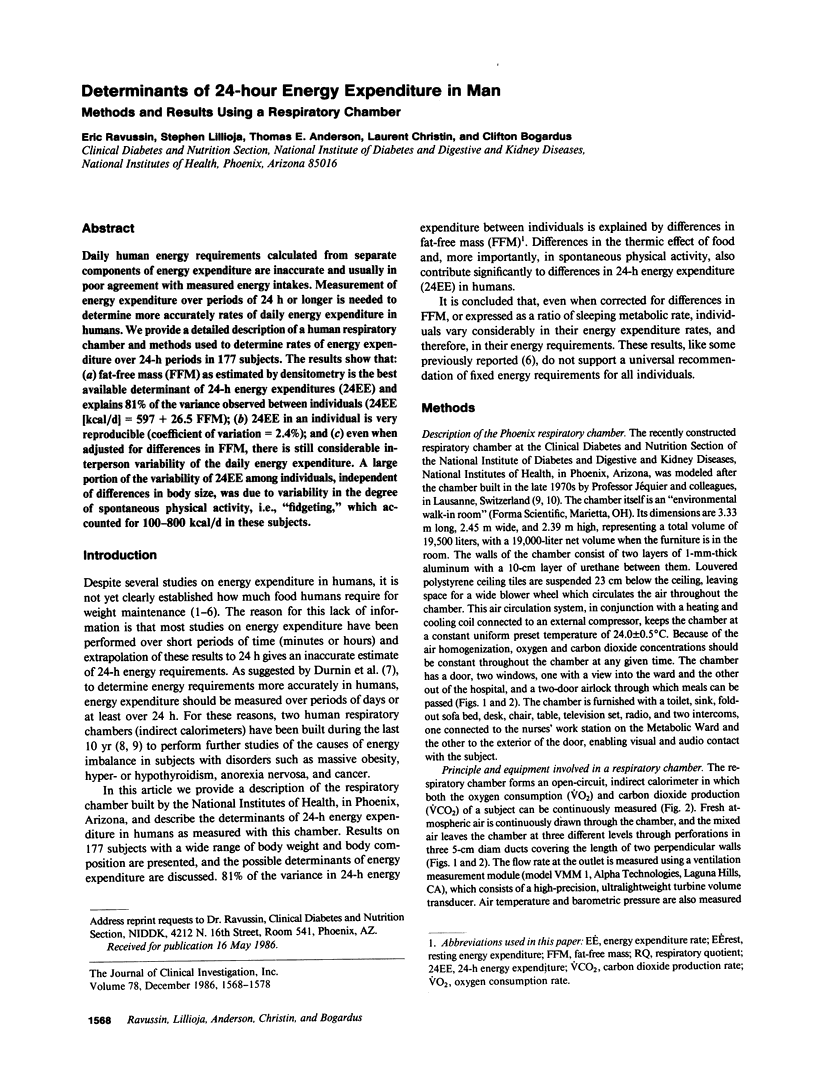
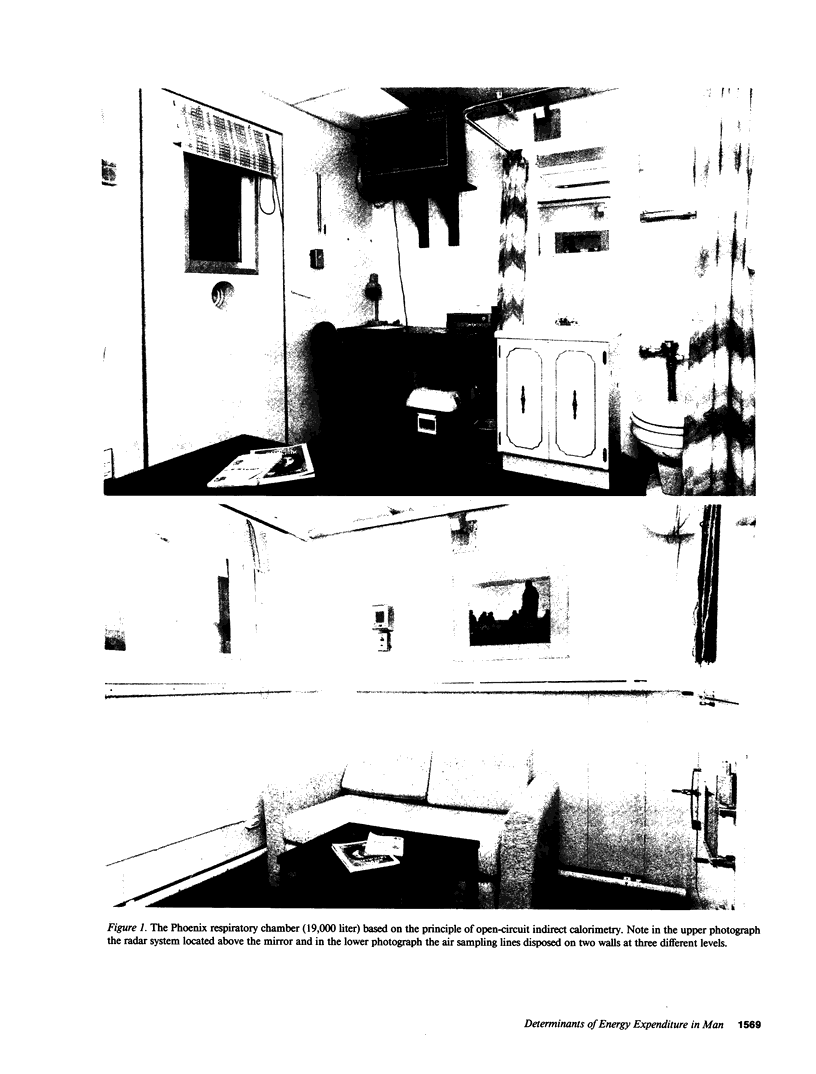

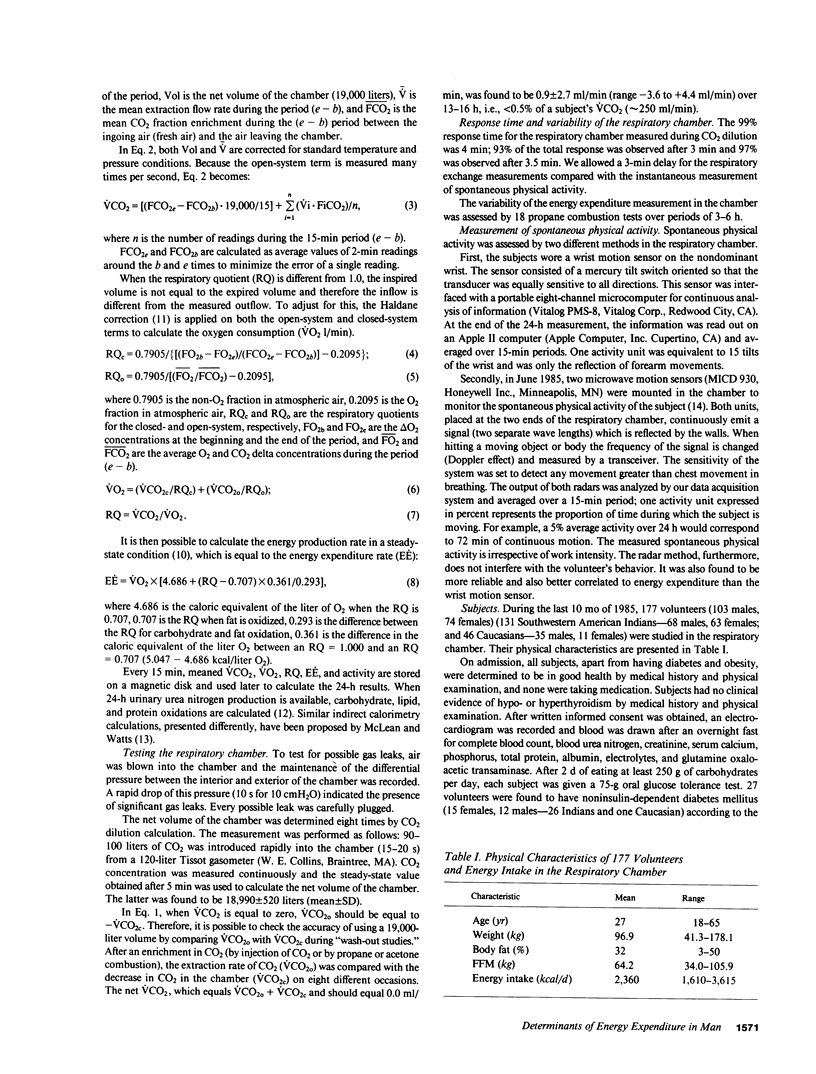
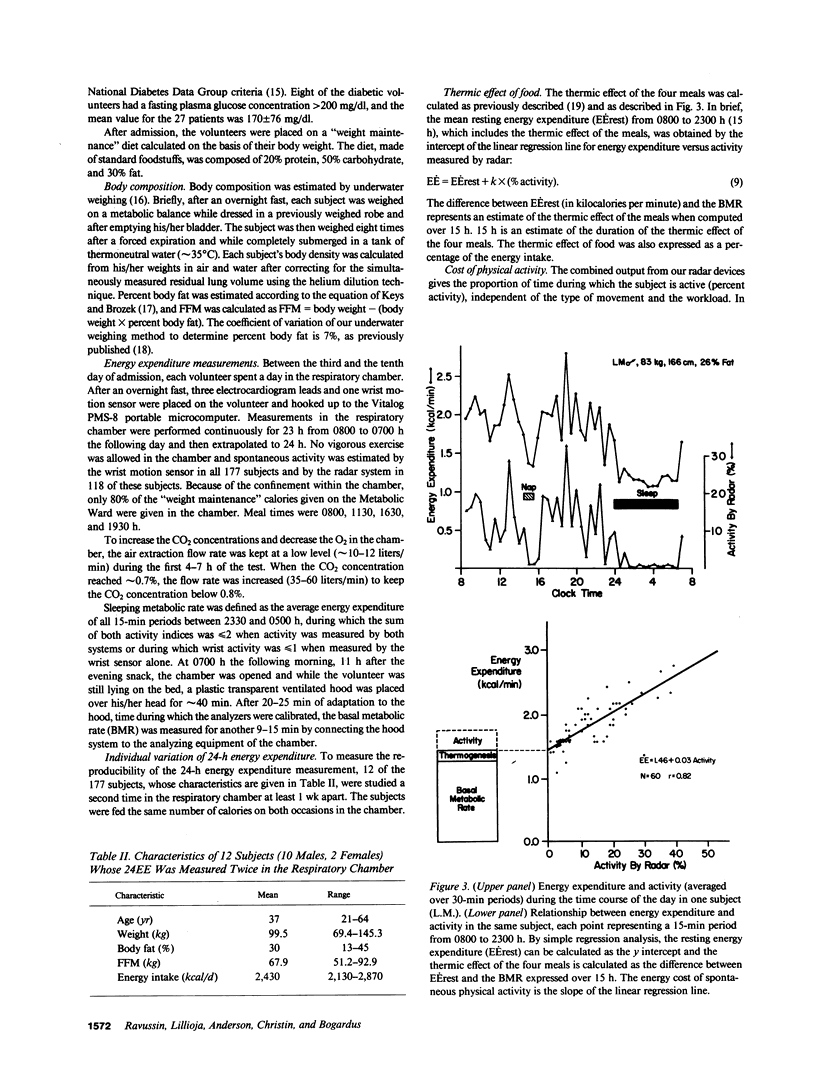

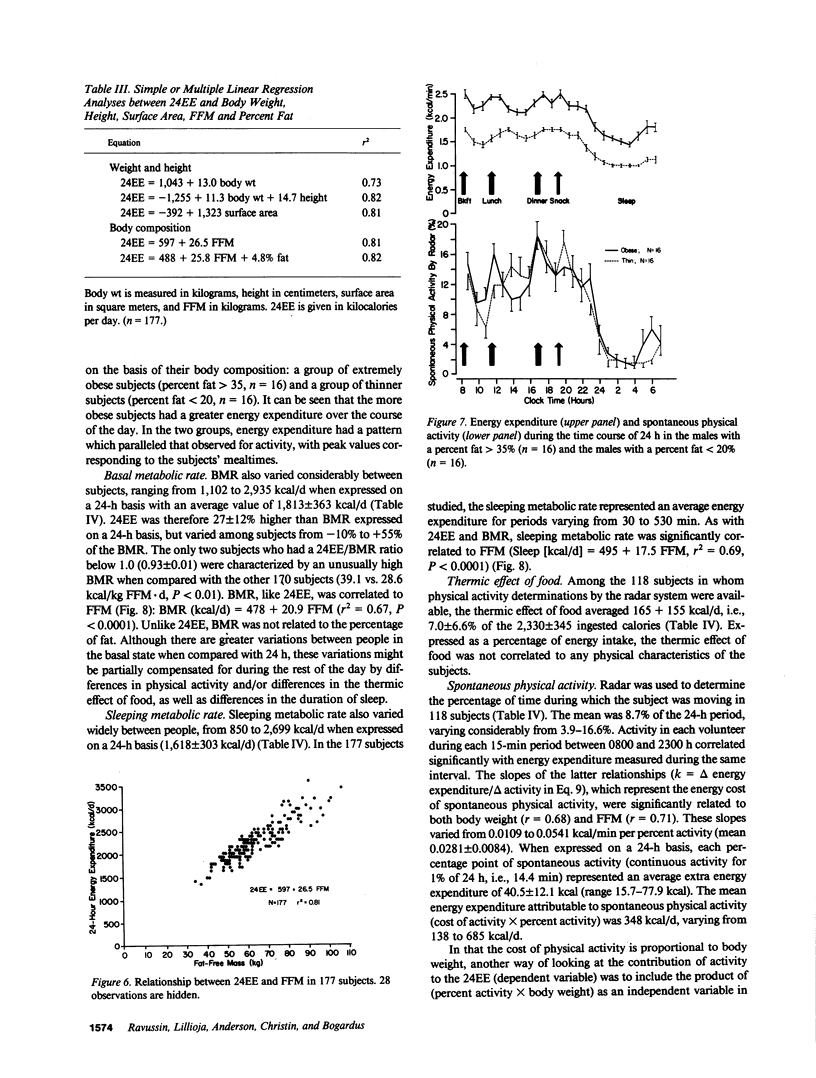
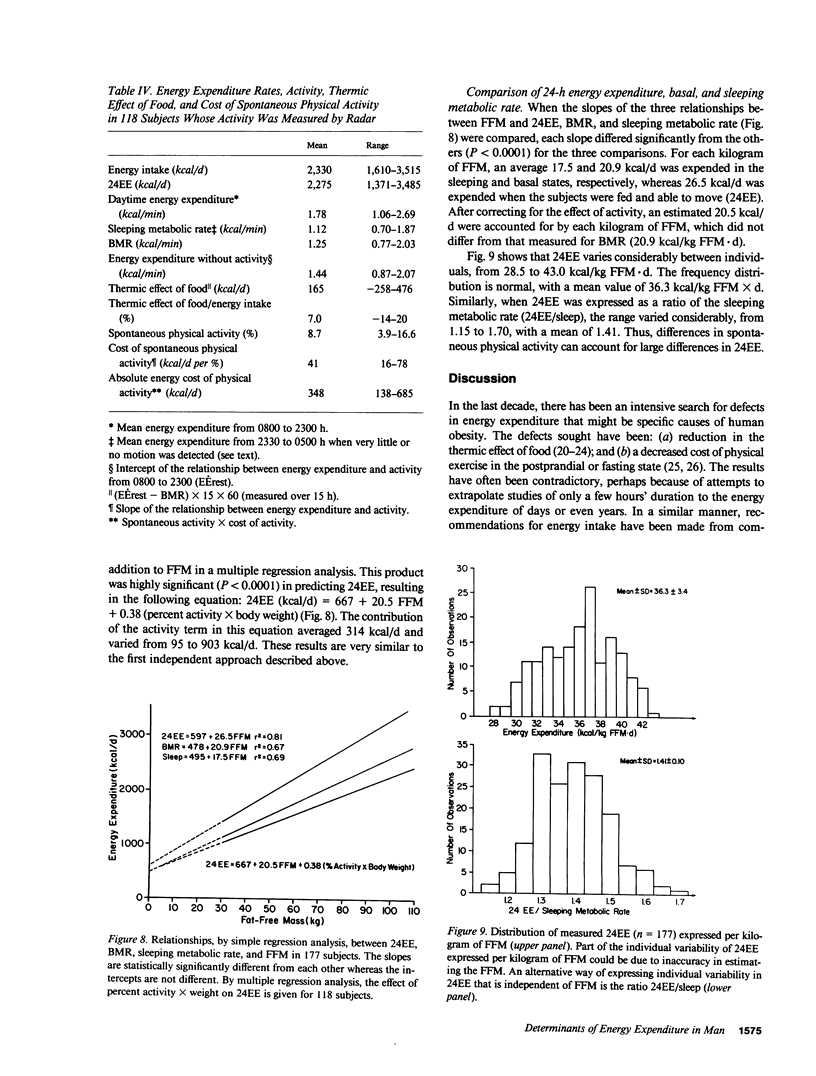
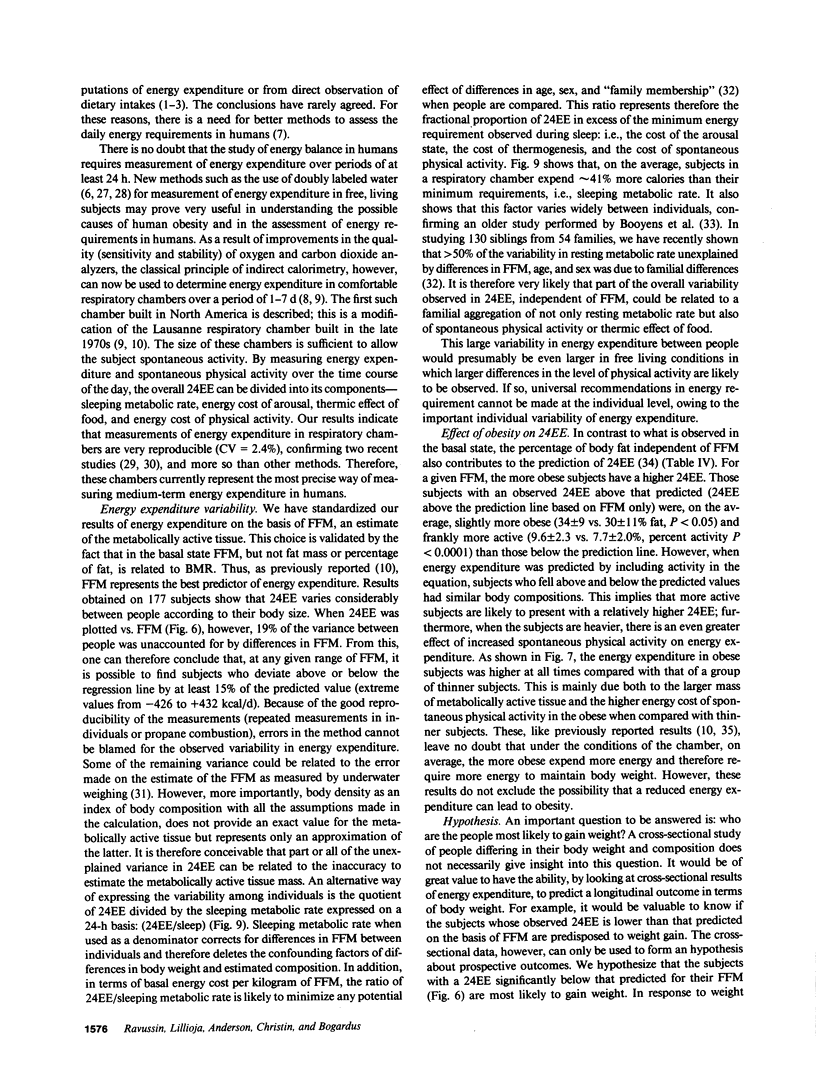
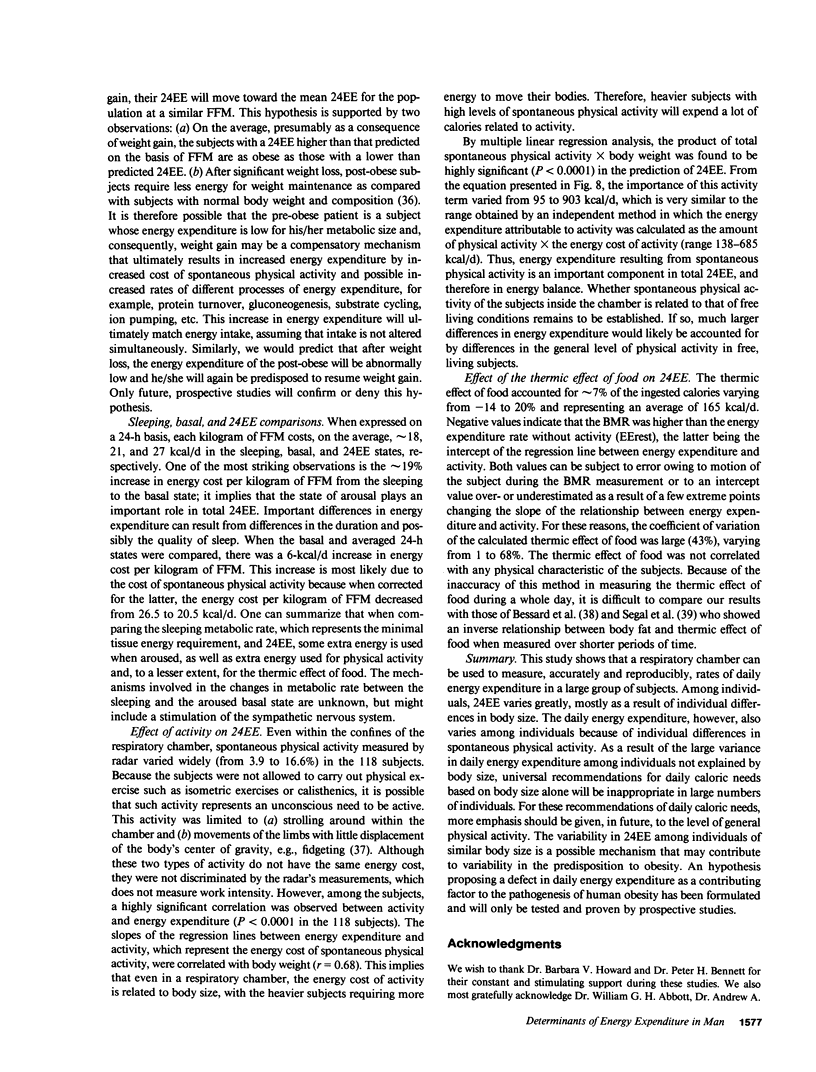
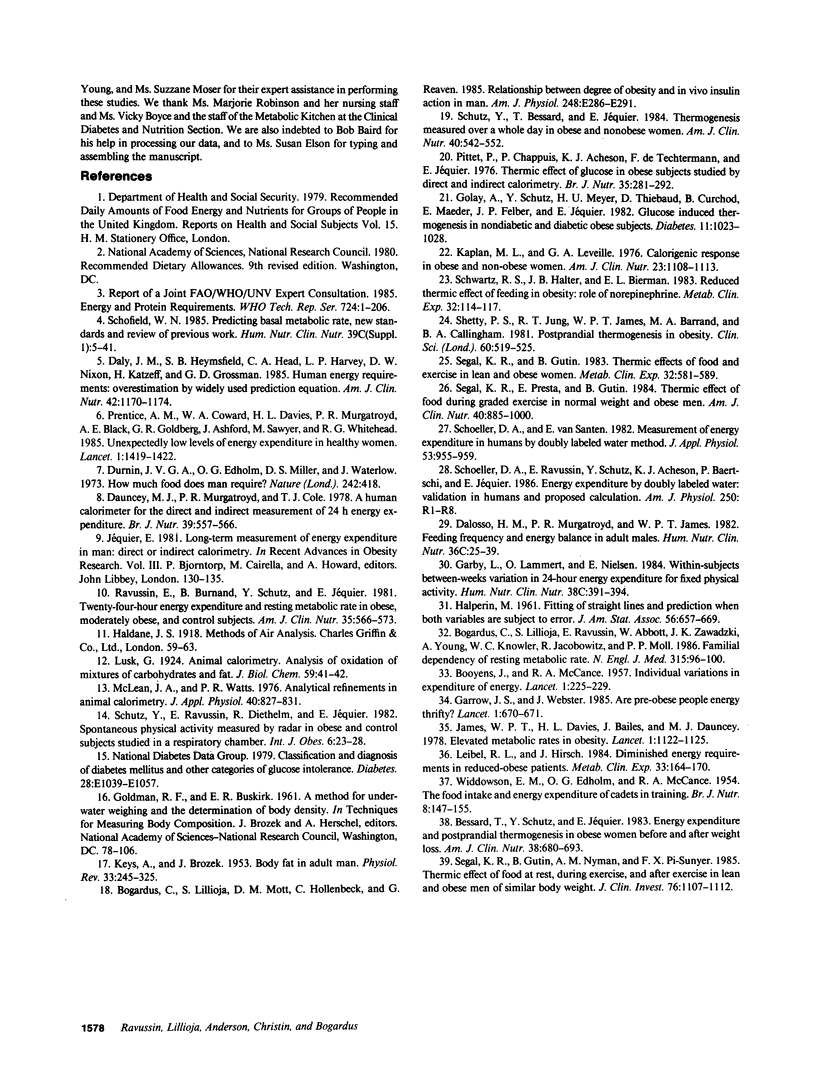
Images in this article
Selected References
These references are in PubMed. This may not be the complete list of references from this article.
- BOOYENS J., MCCANCE R. A. Individual variations in expenditure of energy. Lancet. 1957 Feb 2;272(6962):225–229. doi: 10.1016/s0140-6736(57)90297-0. [DOI] [PubMed] [Google Scholar]
- Bessard T., Schutz Y., Jéquier E. Energy expenditure and postprandial thermogenesis in obese women before and after weight loss. Am J Clin Nutr. 1983 Nov;38(5):680–693. doi: 10.1093/ajcn/38.5.680. [DOI] [PubMed] [Google Scholar]
- Bogardus C., Lillioja S., Mott D. M., Hollenbeck C., Reaven G. Relationship between degree of obesity and in vivo insulin action in man. Am J Physiol. 1985 Mar;248(3 Pt 1):E286–E291. doi: 10.1152/ajpendo.1985.248.3.E286. [DOI] [PubMed] [Google Scholar]
- Bogardus C., Lillioja S., Ravussin E., Abbott W., Zawadzki J. K., Young A., Knowler W. C., Jacobowitz R., Moll P. P. Familial dependence of the resting metabolic rate. N Engl J Med. 1986 Jul 10;315(2):96–100. doi: 10.1056/NEJM198607103150205. [DOI] [PubMed] [Google Scholar]
- Dallosso H. M., Murgatroyd P. R., James W. P. Feeding frequency and energy balance in adult males. Hum Nutr Clin Nutr. 1982;36C(1):25–39. [PubMed] [Google Scholar]
- Daly J. M., Heymsfield S. B., Head C. A., Harvey L. P., Nixon D. W., Katzeff H., Grossman G. D. Human energy requirements: overestimation by widely used prediction equation. Am J Clin Nutr. 1985 Dec;42(6):1170–1174. doi: 10.1093/ajcn/42.6.1170. [DOI] [PubMed] [Google Scholar]
- Dauncey M. J., Murgatroyd P. R., Cole T. J. A human calorimeter for the direct and indirect measurement of 24 h energy expenditure. Br J Nutr. 1978 May;39(3):557–566. doi: 10.1079/bjn19780071. [DOI] [PubMed] [Google Scholar]
- Durnin J. V., Edholm O. G., Miller D. S., Waterlow J. C. How much food does man require? Nature. 1973 Apr 6;242(5397):418–418. doi: 10.1038/242418a0. [DOI] [PubMed] [Google Scholar]
- Garby L., Lammert O., Nielsen E. Within-subjects between-weeks variation in 24-hour energy expenditure for fixed physical activity. Hum Nutr Clin Nutr. 1984 Sep;38(5):391–394. [PubMed] [Google Scholar]
- Garrow J. S., Webster J. Are pre-obese people energy thrifty? Lancet. 1985 Mar 23;1(8430):670–671. doi: 10.1016/s0140-6736(85)91330-3. [DOI] [PubMed] [Google Scholar]
- Golay A., Schutz Y., Meyer H. U., Thiébaud D., Curchod B., Maeder E., Felber J. P., Jéquier E. Glucose-induced thermogenesis in nondiabetic and diabetic obese subjects. Diabetes. 1982 Nov;31(11):1023–1028. doi: 10.2337/diacare.31.11.1023. [DOI] [PubMed] [Google Scholar]
- James W. P., Davies H. L., Bailes J., Dauncey M. J. Elevated metabolic rates in obesity. Lancet. 1978 May 27;1(8074):1122–1125. doi: 10.1016/s0140-6736(78)90300-8. [DOI] [PubMed] [Google Scholar]
- KEYS A., BROZEK J. Body fat in adult man. Physiol Rev. 1953 Jul;33(3):245–325. doi: 10.1152/physrev.1953.33.3.245. [DOI] [PubMed] [Google Scholar]
- Kaplan M. L., Leveille G. A. Calorigenic response in obese and nonobese women. Am J Clin Nutr. 1976 Oct;29(10):1108–1113. doi: 10.1093/ajcn/29.10.1108. [DOI] [PubMed] [Google Scholar]
- Leibel R. L., Hirsch J. Diminished energy requirements in reduced-obese patients. Metabolism. 1984 Feb;33(2):164–170. doi: 10.1016/0026-0495(84)90130-6. [DOI] [PubMed] [Google Scholar]
- McLean J. A., Watts P. R. Analytical refinements in animal calorimetry. J Appl Physiol. 1976 May;40(5):827–831. doi: 10.1152/jappl.1976.40.5.827. [DOI] [PubMed] [Google Scholar]
- Pittet P., Chappuis P., Acheson K., De Techtermann F., Jéquier E. Thermic effect of glucose in obese subjects studied by direct and indirect calorimetry. Br J Nutr. 1976 Mar;35(2):281–292. doi: 10.1079/bjn19760033. [DOI] [PubMed] [Google Scholar]
- Prentice A. M., Coward W. A., Davies H. L., Murgatroyd P. R., Black A. E., Goldberg G. R., Ashford J., Sawyer M., Whitehead R. G. Unexpectedly low levels of energy expenditure in healthy women. Lancet. 1985 Jun 22;1(8443):1419–1422. doi: 10.1016/s0140-6736(85)91846-x. [DOI] [PubMed] [Google Scholar]
- Ravussin E., Burnand B., Schutz Y., Jéquier E. Twenty-four-hour energy expenditure and resting metabolic rate in obese, moderately obese, and control subjects. Am J Clin Nutr. 1982 Mar;35(3):566–573. doi: 10.1093/ajcn/35.3.566. [DOI] [PubMed] [Google Scholar]
- Schoeller D. A., van Santen E. Measurement of energy expenditure in humans by doubly labeled water method. J Appl Physiol Respir Environ Exerc Physiol. 1982 Oct;53(4):955–959. doi: 10.1152/jappl.1982.53.4.955. [DOI] [PubMed] [Google Scholar]
- Schofield W. N. Predicting basal metabolic rate, new standards and review of previous work. Hum Nutr Clin Nutr. 1985;39 (Suppl 1):5–41. [PubMed] [Google Scholar]
- Schutz Y., Bessard T., Jéquier E. Diet-induced thermogenesis measured over a whole day in obese and nonobese women. Am J Clin Nutr. 1984 Sep;40(3):542–552. doi: 10.1093/ajcn/40.3.542. [DOI] [PubMed] [Google Scholar]
- Schutz Y., Ravussin E., Diethelm R., Jequier E. Spontaneous physical activity measured by radar in obese and control subject studied in a respiration chamber. Int J Obes. 1982;6(1):23–28. [PubMed] [Google Scholar]
- Schwartz R. S., Halter J. B., Bierman E. L. Reduced thermic effect of feeding in obesity: role of norepinephrine. Metabolism. 1983 Feb;32(2):114–117. doi: 10.1016/0026-0495(83)90214-7. [DOI] [PubMed] [Google Scholar]
- Segal K. R., Gutin B., Nyman A. M., Pi-Sunyer F. X. Thermic effect of food at rest, during exercise, and after exercise in lean and obese men of similar body weight. J Clin Invest. 1985 Sep;76(3):1107–1112. doi: 10.1172/JCI112065. [DOI] [PMC free article] [PubMed] [Google Scholar]
- Segal K. R., Gutin B. Thermic effects of food and exercise in lean and obese women. Metabolism. 1983 Jun;32(6):581–589. doi: 10.1016/0026-0495(83)90028-8. [DOI] [PubMed] [Google Scholar]
- Segal K. R., Presta E., Gutin B. Thermic effect of food during graded exercise in normal weight and obese men. Am J Clin Nutr. 1984 Nov;40(5):995–1000. doi: 10.1093/ajcn/40.5.995. [DOI] [PubMed] [Google Scholar]
- Shetty P. S., Jung R. T., James W. P., Barrand M. A., Callingham B. A. Postprandial thermogenesis in obesity. Clin Sci (Lond) 1981 May;60(5):519–525. doi: 10.1042/cs0600519. [DOI] [PubMed] [Google Scholar]
- WIDDOWSON E. M., EDHOLM O. G., McCANCE R. A. The food intake and energy expenditure of cadets in training. Br J Nutr. 1954;8(2):147–155. doi: 10.1079/bjn19540023. [DOI] [PubMed] [Google Scholar]




